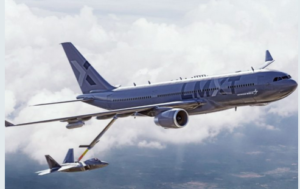Leeham News and Analysis
There's more to real news than a news release.
Lockheed Martin sees LMXT as complementary to KC-46A, not competitive
Subscription Required
Now open to all readers
By Scott Hamilton
Jan. 30, 2022, © Leeham News: Lockheed Martin’s LMXT US Air Force refueling tanker will be a complementary offer to the service in the forthcoming KC-Y competition.
In an exclusive interview with LNA earlier this month, Lockheed Martin (LMCO)’s LMXT Campaign Director, Larry Gallogly, said the Air Force wants an airplane that is bigger, has more range, and more fuel offload than the incumbent Boeing KC-46A. This fits the LMXT, based on the Airbus A330-200 Multi-Role Tanker Transport (MRTT) now in production.
Airbus partnered with LMCO in 2018 to prepare for the KC-Y competition. Airbus has 61 orders for the MRTT from around the world. Boeing is building 179 tankers for the Air Force from the original KC-X competition. It has a handful of orders from other countries.
The KC-Y contact will be for up to 160 tankers. The competition will pit Boeing and Airbus against each other for the third time. Airbus first teamed with Northrop Grumman in the first round of the KC-X campaign. Northrop won the contract, but the award was protested successfully by Boeing. Northrop dropped out of the recompete, with Airbus going alone. This time, Lockheed Martin will be the lead, and Airbus the subcontractor.
The two fights were bitterly waged in the public and political domains. LMCO hopes to avoid a repeat.
No plans to relitigate
“We have, from the start of this, with both ourselves and Airbus, have had no intention of re-litigating the [KC-X] competition,” Gallogly said. “Our goal has always been to provide what we consider to be a complementary capability. There are going to be 179 KC-46s out there, but there are significant capability gaps that the US Air Force has that this LMXT can fill. We are not trying to provide the same capability in a different wrapper. Our goal is to provide a very different capability and, again, fill those gaps.”
Gallogly said that after talking to the Air Force and Pentagon repeatedly, from the Air Mobility Command to transportation command to the individual theater commanders, to the people in the Pentagon, “what we heard consistently was that the gap exists for fuel offload at strategic ranges. You know as everybody who focuses on the Pacific Theater, you’re faced with the tyranny of distance there, and we needed to provide as much fuel offload as we possibly could.”
Enhancing the MRTT
The LMXT enhances the MRTT, Gallogly said. Not all customers for the MRTT have the same requirements as set forth by the Air Force. But LMCO plans to meet whatever requirements are set forth by the USAF.
“We’ve put some fuel tanks in the lower cargo bay that will give us an extra 25,000 pounds of offload and even with that extra gas added in a lower cargo bay, we still have cargo-carrying capability for up to six standard military pallets,” Gallogly said. “Those are restricted-height pallets. They’re 67 inches as opposed to a maximum of 97 inches, but it’s going to allow the airplane to deploy with a good set of its support equipment, power carts and things like that, that will be necessary to operate from various locations.”
Electro-magnetic protection (EMP) isn’t required by some current customers for the MRTT. The USAF required it for the KC-X and is expected to do so for KC-Y. LMCO will comply.
Awaiting RFP
The Air Force so far only issued a Request for Information. The Request for Proposals will be issued this year. So LMCO is going by discussions its had for its direction to date—complementary to KC-46A, filling gaps beyond the KC-46A’s capabilities.
“We don’t have an RFP yet. We don’t have the requirements exactly right. We know that. What we’ve tried to do is anticipate the requirements, based on that interaction with the customer, and design an aircraft that could meet those requirements best,” Gallogly said.
So far, this means the KC-Y doesn’t need a main deck cargo door. The No. 1 priority is extra fuel offload at strategic ranges.
TALP or capacity
The second round of the KC-X competition, the one that Boeing won, was based on a Technically Acceptable, Lowest Price (TALP) requirement. The standard was whether the Airbus or Boeing offers Passed or Failed a set of standards based on the Boeing KC-135 capabilities. The extra range, tankage, and cargo of the MRTT weren’t given extra credit unless the bids came within 1% of each other. Boeing bid nearly 10% less than Airbus, rendering the extra credit moot.
Gallogly freely acknowledged that in KC-Y, LMCO will be more expensive with the LMXT than Boeing offering the KC-46A. But, he said, these are different airplanes, so of course, the LMXT will be more expensive.
This begs the question, then: If the Air Force indeed wants a plane that is larger than the KC-46A, will Boeing nevertheless stick with this model and the lower capital and operating costs it affords? Or might Boeing offer a tanker based on the larger 767-300ERF or the still larger 777-200LRF? Technically, either of the latter could be designed into a tanker. At one point, Boeing even floated a KC-777 concept. Boeing was unable to respond in time for this article.


